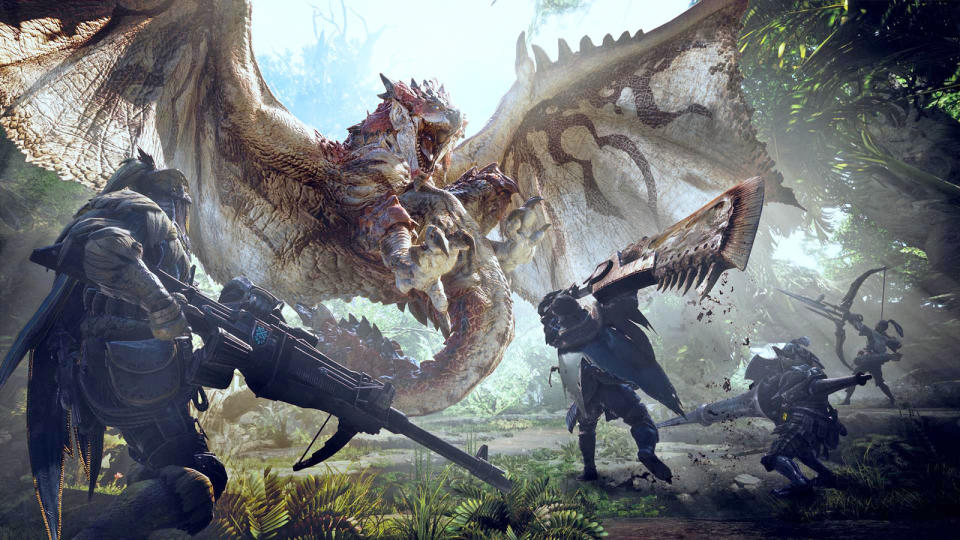‘Monster Hunter: World’ is the best way to fight bosses with friends
If you love teaming up to take down big enemies, this is your dream.
Monster Hunter: World is the latest entry in a decade-plus game franchise dedicated to killing huge monsters. But the series has another reputation: barely explained mechanics, labyrinthine menus and difficult co-op play. Capcom smoothed out a lot of those rough edges for Monster Hunter: World and released it simultaneously worldwide, which has made it the most accessible of the franchise. Now, finally, it can take the crown as the best co-op boss fight experience out there.
Fighting giant enemies is a thrilling niche in gaming, from blowing up Kraid in Super Metroid to taking on one titanic monolith after another in Shadow of the Colossus. But those are insular single-player journeys, not communal experiences. When games have tried team boss fights before, most notably in MMOs, they're often at the end of a long raid after slogging through a multilevel dungeon. Monster Hunter: World is the large boss fight distilled, a stripped-down contest between small humans and colossal beasts in 20- to 50-minute chunks.
Fighting a boss in the time it takes to wash a load of laundry is great. And the game makes it decently easy to drop into a hunt in progress, which means you're not wasting time assembling a party like you would in an MMO. You'll have to learn an obtuse method to hop into another player's mission, but considering how rough it was to join forces in previous Monster Hunter games, the mechanism is far more accessible and reliable in this iteration.
Monster Hunter: World's most unsung contribution to boss fights, however, is liberating players from the shackles of classes. The game doesn't force everyone to gravitate toward a role and a restricted ability kit; nobody has to play the healer or the tank. Instead, you choose from a wild assortment of weapons, each with its own semi-absurd play style. The Long Sword is a balanced weapon with some reach that won't leave you too open, while the enormous Buster Sword is so heavy you'll careen around the battlefield trying to time your achingly slow, catastrophically damaging swings. Of course, it's easier to hit a monster when a buddy is distracting it, so you'll often fluidly switch between mini-roles during battle, according to your team's needs and weapon capabilities.
If you want to fill a traditional role, like support, you can. But you do it by using the game's bonkers logic, like shooting your allies with armor-boosting arrows. Me, I'm a purist: Give me a set of bagpipes that I can slam into an enemy one moment and use to play a healing melody the next, and I will live that bard life. The game makes you commit to this play style, leaving you agonizingly open while you toot your battle horn. But even this cumbersome process has its own seductive flair: While my allies are frantically dodging a flailing mega-dinosaur, I'm blaring a slow-marching dirge like a Jurassic Jack Churchill.

All of this -- the relative ease of joining up, the variety of weapon play styles -- wouldn't matter if the monster battles weren't actually fun. And for the most part, they are, even if they don't pose the same challenges as "traditional" bosses. Monsters don't have complex attack patterns or multi-stage forms, but they are frequently lethal and imposing, thanks to their own idiosyncratic behaviors, which make them feel wild, unbound and unpredictable. Sometimes they wander into one another's territory, triggering violent turf battles where prehistoric titans tear into each other. Sometimes they'll outright leave a fight to eat smaller creatures and regain health. Sometimes they'll sleep. Like Odysseus' crew, you'll have to summon the courage to sneak up and stab a giant being many times your size, and hope you're quick enough to evade its wrath.
It's refreshing that these beasts are such ciphers -- unknown quantities in an unknown land. In many games, bosses contain a multitude of previously encountered challenges, as a sort of game mechanics final exam. You don't get the methodical preparation of clearing dungeon floors in Monster Hunter: World; instead, you are sent into the wild with only a beast's name to chase. It's not hard to bypass every smaller creature on the way to your chosen mark, so there's no real opportunity to warm up: Once a monster knows you've come for its head, you're in the fight until one of you dies.
Every time I (or a friend) land the killing blow on a monster, I let out a breath I didn't know I was holding in. Although you can see the strength of each strike, and there are some small tells when it's really injured, the game's monsters have no health bars. This forces players to keep hustling and treat every fight as if it's endless, until suddenly it's over.
In keeping with the game's weirdly pragmatic aesthetic, the post-combat denouement is a visceral, communal harvesting of the fallen beast until nothing is left. If you're on voice chat with your friends, everyone nervously giggles at this macabre ritual of ripping out materials needed to improve gear, literally creating weapons and armor from the flesh of your enemies. But there's something utterly righteous and primal about it too. You've just survived life-or-death combat with a giant, deadly boss -- and you're just minutes away from jumping into your next battle.





